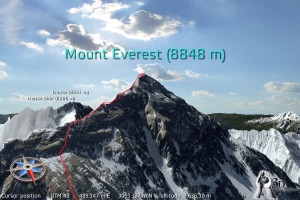(English) 3D models of Mt Everest flights soon


KATHMANDU, Nepal – A first 3D models of the flight on the top of the world will be available in the coming weeks as a 3D camera in a motorized glider captured the flight as it travelled over the rocky terrain of Mount Everest. And the researchers are working on building a 3D model of the Himalaya aiming to help improve forecasts of landslides and floods.
German pilots Klaus Ohlmann and Jona Keimer, mounted the specialist Modular Airborne Camera System (MACS) to the wing of a Stemme S10-VTX glider before making the trip over Everest’s summit – 8,848 metres above sea level.
It is learnt that the footage from the camera will be used to build a high-quality 3D model of the Nepali mountain, with a resolution down to 15 centimetres.
Researchers plan to use this model to help improve forecasts of landslides and floods resulting from the outbursting of glacial lakes, reported newsportal Dailymail in its news report.
“The scheme was set up by the Mountain Wave Project (MWP) and researchers from the German Aerospace Centre, also known as Deutsches Zentrum für Luft-und Raumfahrt (DLR).”
MWP pilots Klaus and co-pilot Jona took an hour and a half to reach the summit, after taking off from the expedition base camp at Pokhara airport on 28 January, the dailymail said.
They flew the glider along the Himalayas towards Mount Everest before using mountain waves to gradually gain altitude.
‘The conditions were ideal, despite the wind speeds at the summit of Everest, which neared 100 kilometres per hour,’ the newsportal quoted Klaus as saying.
‘The almost turbulence-free slope updrafts helped us ascend quickly.’
The MACS camera system, developed and built by DLR, was fitted to the glider in an unpressurised instrument container under the wing.
Its three camera heads, arranged facing toward each other at a lateral slant, give a 120-degree field-of-view and can take high-resolution images of steep slopes.
Due to the cold temperatures of the Himalayan summits, which can drop to below -35 degrees Celsius, engineers had to put the camera through a series of tests before the flight could take off.
The researchers are keeping a blog to provide additional details of their adventurous research expedition to the Himalayas.
According to the agency reports, the aircraft was supplied by the Faculty of Aerospace Technology at the University of Applied Sciences in Aachen.
